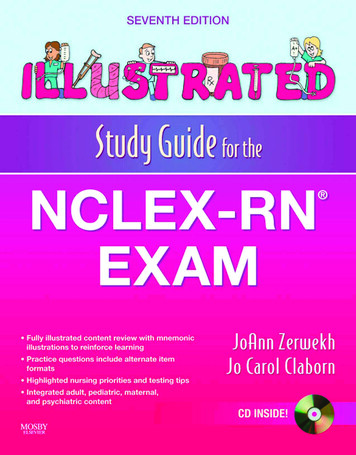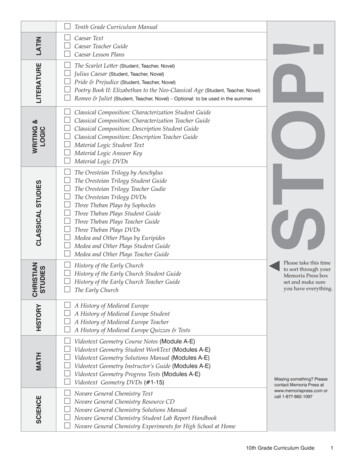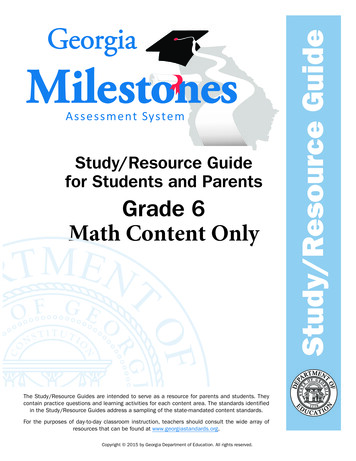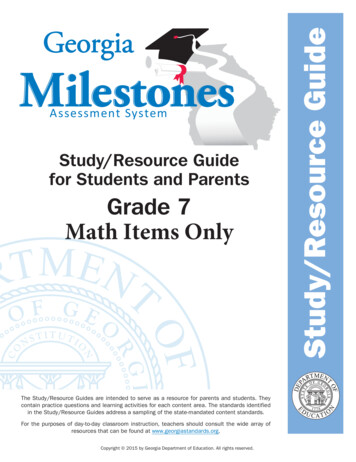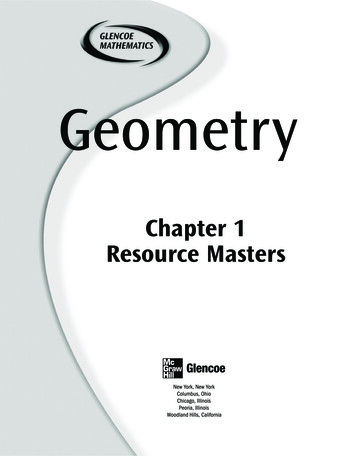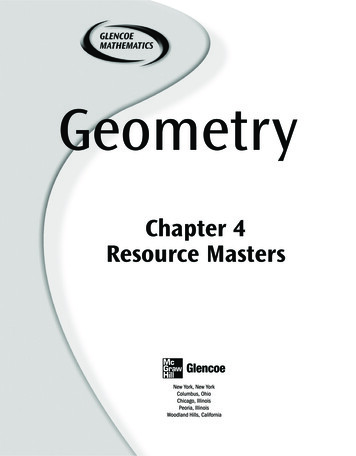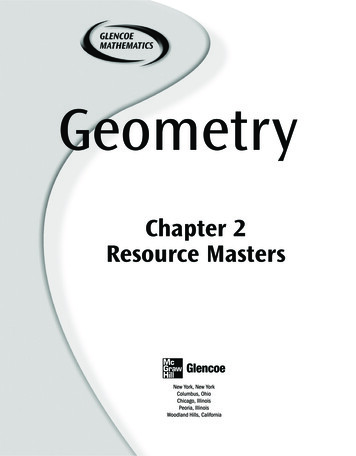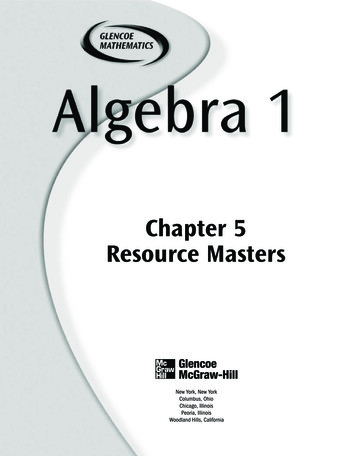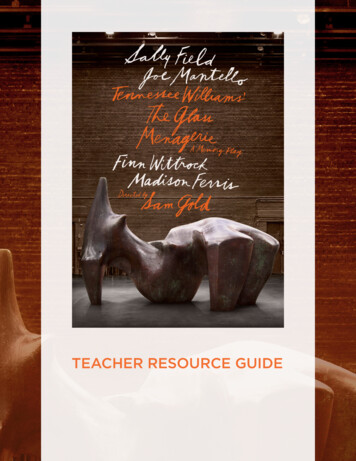
Transcription
TEACHER RESOURCE GUIDE
THE GLASS MENAGERIETeacher Resource Guide by Nicole Kempskie
TABLE OF CONTENTSINTRODUCTION . . . . . . . . . . . . . . . . . . . . . . . . . . . . . . . . . . . . . . . . . . 1THE PLAY . . . . . . . . . . . . . . . . . . . . . . . . . . . . . . . . . . . . . . . . . . . . . . . . 2The Story . . . . . . . . . . . . . . . . . . . . . . . . . . . . . . . . . . . . . . . . . . . . . . . . 2The Characters . . . . . . . . . . . . . . . . . . . . . . . . . . . . . . . . . . . . . . . . . . . 3The Writer . . . . . . . . . . . . . . . . . . . . . . . . . . . . . . . . . . . . . . . . . . . . . . . 4Additional Resources . . . . . . . . . . . . . . . . . . . . . . . . . . . . . . . . . . . . . 5ELEMENTS OF STYLE . . . . . . . . . . . . . . . . . . . . . . . . . . . . . . . . . . . 6Poetic Language . . . . . . . . . . . . . . . . . . . . . . . . . . . . . . . . . . . . . . . . . 6The Memory Play . . . . . . . . . . . . . . . . . . . . . . . . . . . . . . . . . . . . . . . . . 7Plastic Theater . . . . . . . . . . . . . . . . . . . . . . . . . . . . . . . . . . . . . . . . . . . 7Autobiography . . . . . . . . . . . . . . . . . . . . . . . . . . . . . . . . . . . . . . . . . . . 8THEMES & SYMBOLS . . . . . . . . . . . . . . . . . . . . . . . . . . . . . . . . . . . . 9Thematic Elements . . . . . . . . . . . . . . . . . . . . . . . . . . . . . . . . . . . . . . . 9Symbols . . . . . . . . . . . . . . . . . . . . . . . . . . . . . . . . . . . . . . . . . . . . . . . . 10Additional Resources . . . . . . . . . . . . . . . . . . . . . . . . . . . . . . . . . . . . 10PRODUCTION NOTES . . . . . . . . . . . . . . . . . . . . . . . . . . . . . . . . . . . 11From the Director . . . . . . . . . . . . . . . . . . . . . . . . . . . . . . . . . . . . . . . . 11Post-Performance Discussion . . . . . . . . . . . . . . . . . . . . . . . . . . . . . . 11CLASSROOM ACTIVITIES . . . . . . . . . . . . . . . . . . . . . . . . . . . . . . . 12RESOURCES/BIBLIOGRAPHY . . . . . . . . . . . . . . . . . . . . . . . . . 20
INTRODUCTION“ Ininto this ‘memory play’ Tennessee Williams transports usprivate worlds where desire clashes with obduratereality, where loss supplants hope. After more thana half a century we continue to be drawn to a play thatexplores so many aspects of the human condition.Robert Bray, Introduction to The Glass Menagerie (New Directions Edition)”Welcome to the teacher resource guide for Tennessee Williams’ play, The Glass Menagerie. We are delightedthat students will be able to experience this American classic in a stunning new Broadway production starringtwo-time Academy Award winner Sally Field as Amanda Wingfield and two-time Tony Award winner JoeMantello as Tom Wingfield. Director Sam Gold, winner of the Tony Award for the musical Fun Home, will berecreating a production he first directed at Toneelgroep Amsterdam.The Glass Menagerie provides many learning opportunities for students in areas related to:››››playwright Tennessee Williams and his legacy;one of the most popular American plays in history;the literary devices and thematic elements embodied in The Glass Menagerie; andunderstanding The Glass Menagerie through a personal lens.HOW TO USE THIS GUIDEArts experiences resonate most strongly for students when themes and ideas from the play can be alignedto your curriculum. This resource guide has been created to help prepare your students to see The GlassMenagerie. We also hope to direct you to resources that can further your classroom exploration of the play.We encourage you to print and share pages of this guide with your students. Throughout the guide you willfind resources, including links to materials and videos available online, as well as discussion questions andsuggested classroom activities that you can use before or after seeing the production.The overall goals of this guide are to:› connect to your curriculum with standards-based information and activities;› engage your students’ critical and analytical thinking skills; and› provide your students with an educational framework for their visit to the theater.THE GLASS MENAGERIE Teacher Resource GuideIntroduction Page 1
THE PLAYThe StoryAs the play opens, Tom Wingfield, the play’s narrator, addresses the audience. He explains that the events thatare to follow are fragments of his memory. Set in a cramped St. Louis apartment in the 1930s, Tom’s storyrevolves around his troubled relationship with his overbearing mother Amanda and his shy and fragile sisterLaura, who walks with a limp due to a childhood illness. Tom’s father abandoned the family years earlier, andTom must support his mother and sister by doing a job he detests at a shoe factory.As Tom steps into the action of the play, the personalities and tribulations of the family members spring to life:Amanda’s desperate and often outrageous attempts to relive her idealized past and better the lives of her children; Laura’s extreme reclusiveness and withdrawal from reality; and Tom’s fiery desire to escape the burdensplaced on him by his family and circumstances.When Amanda asks Tom if he will bring home a “gentleman caller,” or potential suitor for Laura, and promisesthat once Laura is married he will be free to leave home for good, the stakes rise for each of the characters. AsJim O’Connor, Tom’s co-worker from the factory and Laura’s high school crush, enters the story, the dreamsand hopes of the characters come to the surface in a shattering conclusion.Madison Ferris, Sally Field, and Joe Mantello in The Glass Menagerie. Photo by Julieta Cervantes.THE GLASS MENAGERIE Teacher Resource GuideThe Play Page 2
The CharactersFinn Wittrock playsJim O’Connor.Sally Field playsAmanda Wingfield.Madison FerrisplaysLaura Wingfield.AMANDA WINGFIELD: Laura and Tom’s mother.› For a full character analysis, erie/characters/amanda-wingfieldTOM WINGFIELD: Amanda’s son and Laura’s younger brother.› For a full character analysis, erie/characters/tom-wingfieldJoe Mantello playsTom Wingfield.LAURA WINGFIELD: Amanda’s daughter and Tom’s older sister.› For a full character analysis, erie/characters/laura-wingfieldJIM O’CONNOR: A friend and co-worker of Tom’s, and a formerhigh school classmate of Laura’s.› For a full character analysis, erie/characters/jim-o-connorTHE GLASS MENAGERIE Teacher Resource GuideThe Play Page 3
The WriterTENNESSEE WILLIAMS was born ThomasLanier Williams in Mississippi in 1911. Duringhis early childhood, Williams’ family lived with hisgrandparents in rural Mississippi while his fathertraveled for work as a salesman. When Williams wasseven, his father took a job at a shoe factory in St.Louis, Missouri. Adjusting to life in a cramped cityapartment was difficult for Williams and his siblingsDakin and Rose, as well as for his mother. As tensionsgrew between his alcoholic father and unhappymother, Williams sought refuge in the imaginaryworlds he created with Rose, and in the poems andshort stories he began to write at the age of 12.In 1929, Williams enrolled in the Missouri School ofJournalism. However, in 1932, when his grades beganto slide his father removed him from school and forced him to take a job at the shoe factory where hewas employed. For months, Williams worked at a job he hated during the day and spent his eveningswriting, often straight through the night. Theseconstricting circumstances led Williams tohave an emotional and physical breakdown. Heeventually returned to school and graduatedfrom the University of Iowa in 1938. While hewas away at college, his sister Rose became moreand more unstable, and eventually was admittedto a sanitarium where she was diagnosed withschizophrenia.In 1943, Williams completed a short story withcharacters inspired by his mother and Rose calledPortrait of a Girl in Glass that he later adaptedinto a screenplay called The Gentleman Caller.When MGM Studios rejected the screenplay,Williams adapted it into the play that becameThe Glass Menagerie. That same year, Rose wasAbove: Tennessee Williams at the 20th Anniversary performance ofThe Glass Menagerie. The Library of Congress Prints and PhotographsDivision, 1965. Photo by Orlando Fernandez.Left: Tennessee Williams. NYTWS Collection. The Library of CongressPrints and Photographs Division.THE GLASS MENAGERIE Teacher Resource GuideThe Play Page 4
given a pre-frontal lobotomy, a now-obsolete brain operation that was used to treat mental illness.This operation left her mentally disabled for the rest of her life.The following year, The Glass Menagerie wasproduced in Chicago where it received accoladesfrom the critics and became an instant success. Thefollowing spring it opened on Broadway to soldout audiences, running for 563 performances andskyrocketing Williams from obscurity to fame.Throughout his life, Williams would write twonovels, two books of poetry, 15 screenplays, anautobiography, numerous essays, and 70 plays,including: A Streetcar Named Desire, The RoseTattoo, Cat on a Hot Tin Roof, Suddenly LastSummer, and The Night of the Iguana. During hiscareer he won two Pulitzer Prizes for drama,four New York Drama Critics’ Circle Awards, aTony Award, and he was awarded the PresidentialMedal of Freedom by President Jimmy Carter.He died when he was 73 years old in 1981.Tennessee Williams. The New York Public Library Digital Collections, 1955.Additional resourcesThe Poetry Foundation› A comprehensive biography that traces the full trajectory of Williams’ life, career, and works, as well as hisprominent place within the world of twentieth-century literature and oets/poets/detail/tennessee-williamsPBS American Masters› A succinct overview of Williams’ life and work with supplementary details about his personal and ms/737/Study.com: Tennessee Williams› A comprehensive student-friendly biography and examination of Williams’ style. A video biography is ssee-williams-biography-works-and-style.htmlTHE GLASS MENAGERIE Teacher Resource GuideThe Play Page 5
ELEMENTS OF STYLEThere are a multitude of high quality online resources about the stylistic elements of Williams’ writing, andspecifically, The Glass Menagerie. The following section breaks down the most prominent elements in the playand provides a comprehensive overview of supplementary resources and lesson plans.Poetic Languagemuch more “ Williams,than any other Americanplaywright, succeededin finding a poeticdiction for the stage.I immediately identifiedwith that ambition,with the desire towrite language thatFinn Wittrock and Madison Ferris in The Glass Menagerie. Photo by Julieta Cervantes.simultaneously soundedlike spontaneousutterance but also had the voluptuousness in daring, peculiarity,quirkiness, and unapologetic imagistic density of poetry.”Playwright Tony KushnerResources to explore:› University of Texas: Q and A: Playwright Tony Kushner Speaks About the Influence of Tennessee Williams An interview with esteemed playwright Tony Kushner (Angels in America) in which he discussesWilliams’ legacy and how it has influenced his -of-tennessee-williams/› National Endowment for the Humanities: Why Expressionism? “The Glass Menagerie”: A CommonCore Exemplar A three-lesson curricular unit that explores the role of expressionism and the poetic devices in The ore-exemplarTHE GLASS MENAGERIE Teacher Resource GuideElements of Style Page 6
The Memory Play“The memory play is a very successful non-linear structural pattern in modern Americandrama. Post-World War II, many American playwrights began to tap into the power ofmemory as a narrative device. Influenced by the forces that were shaping American society,especially the psychoanalytical concepts of Sigmund Freud and Carl Jung, these playwrightsused the concept of memory to fuel non-linear plots and intense character development.”ArtsEdge/The Kennedy CenterResources to explore:› ArtsEdge/The Kennedy Center: Memory Play Lesson Plan A multi-faceted lesson plan focused on The Glass Menagerie that explores the structural and technicaldevices of the memory /lessons/grade-9-12/Memory Play› Utah Shakespeare Festival: What is the Underlying Truth? An essay analyzing The Glass Menagerie and Williams’ creative use of memory as a means to explore thehumanity and psychology of his is-the-underlying-truth› The New York Times: That Uncertain Muse and Witness: Memory reflection on contemporary and classic plays that utilize memory as a storytelling and theatrical device in imApactful ways. A video of actor Zachary Quinto performing one of Tom’s monologues is also included in the article. certain-muse-and-witness-memory.html?rref action click&contentCollection timestopics®ionPlastic Theater “His sensitivity to emotional ambience helped him fashion what he termed ‘plastic theatre’:theatre as a unified system fusing language, staging, music and casting into a whole gestalt.His plastic theatre mingled expressionistic memory and fantasy, Chekhov’s psychology,Ibsen’s social realism, O’Neill’s mythic imagination, Faulkner’s history-stunned south andWilliams’s own symbolic imagination. With a bit of gothic melodrama thrown in for fun, hisproductions sharply diverged from mainstream theatre’s conventional, linear narrative.”Sarah Churchwell, The GuardianResources to explore:› The Guardian: Tennessee Williams Review: John Lahr’s ‘compulsively readable’ biography A book review highlighting significant content from John Lahr’s seminal biography of Williams, includingWilliams’ invention of “plastic theater,” a dramatic departure from the theatrical realism of the john-lahr-review› Tennessee Williams Studies: “The Sculptural Drama”: Tennessee Williams’ Plastic Theater A scholarly article breaking down the components of plastic theater and examining the ways Williamsintegrated them into The Glass journal/work.php?ID 45THE GLASS MENAGERIE Teacher Resource GuideElements of Style Page 7
Autobiography“If you chart what he was doing at the time he wrote the plays in his personal life, it becomesan emotional autobiography so that the plays reflect the man and the man reflects the plays.”John Lahr, Williams biographerResources to explore:› Los Angeles Review of Books: Talking Tennessee:A Conversation with John LahrAn interview with Williams’ biographer, John Lahr, about the lifeand art of Tennessee ng-tennessee-conversation-john-lahr/› The Paris Review: Tennessee Williams, The Art of TheaterA 1981 interview with Tennessee Williams about his life, his work,and the intersection of the two.Mrs. Williams with Rose and Tennessee. The NewYork Public Library Digital Collections, 1911 - 1920. lliams› Primestage Study Guide: Putting it in Context (p.7) Succinct historical, geographical, and literary information contextualizingthe setting, themes, and stylistic components of The Glass urce guides/resource guide glass menagerie.pdf› American Repertory Theater Study Guide Contextual information outlining similarities between TennesseeWilliams’ personal life and his writing.From Tom to Tennessee (pgs. 16-19)St. Louis in the 1930s (pgs. 22-23)https://issuu.com/americanrep/docs/glass toolkit fulldraftYoung Tennessee Williams. The New York PublicLibrary Digital Collections, 1900 – 1957.› Denver Center Study Guide Contextual information about the similarities betweenTennessee Williams’ personal life and his writing. Similarities between the William’s Family and the Wingfields (p.3)Southern Women (p.6) de.pdf› Studio Tenn Study Guide: Autobiographical Comparison Chart (p.8) A chart outlining the autobiographical aspects of Williams’ lifethat can be found in The Glass Menagerie.Rural Mississippi home. The Library of Congress Printsand Photographs Division. 20Menagerie%202015%20FINAL-WEB.pdfTHE GLASS MENAGERIE Teacher Resource GuideElements of Style Page 8
THEMES & SYMBOLSThematic ElementsBelow you will find the main thematic elements outlined, as well as discussion questions that can be used to launcha classroom exploration of The Glass Menagerie. In addition, many of the discussion questions can be used in debateactivities or essay writing assignments. Additional thematic resources can be found at the end of this section.ILLUSION VERSUS REALITY› In what ways are the characters disappointed and dissatisfied by the circumstances of theirlives? In what ways are they disappointed and dissatisfied with each other? In your opinion, istheir disappointment and dissatisfaction justified?› W hat strategies do the characters use to cope with their disappointment and dissatisfaction?› W hat are some of the specific ways the characters use illusions to escape the reality of their lives?› D uring which moments in the play are the characters forced to accept reality?› W hat symbols does the playwright use to explore this theme?FAMILY TIES› How would you describe the relationships between the family members?› W hat obligations does Amanda have to her family? How does she try and uphold them?› W hat obligations have been thrust upon Tom in the absence of his father? How do these obligations limit him?› W hat are Laura’s obligations? How does she succeed or fail at fulfilling them?› How does each character control the others? How is each character controlled by the others?How does this lead to conflict?TRAPS AND ESCAPE› How are each of the characters trapped by their environment, their gender, their class, andtheir circumstances? › W hat actions can they take to escape?› W hat would be the consequences of those actions?› Is true freedom possible for any of the characters? What would be required for each characterto gain their freedom? › W hat does Jim symbolize for this family?MEMORY AND TIME› W hy do you think the playwright chose to present this story as a “memory play?”› W hat are the limitations of memories?› W hat is each character’s relationship to their past, present, and future?› How does their memory of the past affect their actions in the present and affect the way they seethe future?› In what ways is this play “timeless?” How might the struggles of the characters play out today?THE GLASS MENAGERIE Teacher Resource GuideElements of Style Page 9
Symbols“Symbols are nothing but the natural speech of drama.” Tennessee WilliamsSymbols for further exploration:› Laura’s glass animals› The unicorn› The fire escape› Blue Roses› The movies› The victrola› The Merchant Marines› “Malvolio the Magician”› The typewriter› Darkness› Candles› JonquilsFinn Wittrock and Madison Ferris in The Glass Menagerie. Photo by Julieta Cervantes.Additional Resources› Denver Center Study Guide: Themes (p.8)An overview of the primary themes found in The Glass Menagerie with specific textual e-study-guide.pdf› Spark Notes: ThemesAn exploration of the following The Glass Menagerie themes: illusion, escape, and mes.html› Theatrefolk.com: Tennessee Williams Analysis and ExercisesAn analysis of symbols in the play and a downloadable/printable ‘Symbols Worksheet’ for classroom s-and-exercise-tennessee-williams› Bright Hub Education: Teaching Symbolism in The Glass MenagerieTwo classroom activities for exploring the symbols in The Glass the-glass-menagerie/› Novelguide.com: Symbolism in The Glass MenagerieAn overview of the primary symbols found in The Glass terature/novels/symbolism-glass-menagerieTHE GLASS MENAGERIE Teacher Resource GuideElements of Style Page 10
PRODUCTION NOTESFrom the Director“I was in my teens when I saw The Glass Menageriefor the first time. I recognized myself in Tom backthen. In his search for identity and freedom. Inhis longing for a life as a poet. In the jail he livedin. In him, I recognized the fears and the dreamsof every young American man. The play directly addressed me. Now that I am reading it againtwenty years later, I am the father of a daughterand for me it is not so much a play about Tomanymore, but more about Amanda, whom I don’tsee as the slightly comical, bossy mother. It surprises me that I recognize myself in her now, inher tormented love for her children. My bondwith the play is still as strong as it used to be, butit is very different.Director Sam GoldAt the time, the poetic language and the ingenious form appealed to me strongly.But now I see that it is also a very naturalistic play. With great subtlety and an eye fordetail, it provides a view on a family in St. Louis during the late 1930s. I find it interesting to research the poetic language and the banality of the environment at thesame time. I am really looking forward to bringing this fragile, fearless and harrowingautobiographical view of an artist on his own life and family to the stage.” The Glass Menagerie director Sam Gold; Toneelgroep Amsterdam Performance Discussion› Sam Gold’s production has been called “minimalist” by reviewers. What does that mean to you? How doeshis minimalist approach to the set and the staging support the story? How did you envision the set? › W hat choices does the director make to illustrate that this is a memory play told from Tom’s point of view?› How does Tom’s opening monologue set the tone for the play? How does it prepare you for what you areabout to see and experience?› How is music used? How does it affect the storytelling and mood?› W hy do you think the director chose to use the full extent of the stage, including the parts that aretraditionally masked or hidden from the audience by curtains and set pieces?› W hat choices does the director make to highlight Laura’s physical challenges and vulnerability?› How is the stage transformed during Laura’s romantic interaction with Jim?THE GLASS MENAGERIE Teacher Resource GuideProduction Notes Page 11
CLASSROOM ACTIVITIESA Web of Symbols: Visual Art Activity› IdentifyAs a class, after reading or seeing the play, brainstorm a list for each character identifying and outliningtheir qualities, attributes, and personality traits.› CollectAsk students to choose a character and collect three images and/or objects that they feel are representativeof their character, reminding them to think symbolically as well as literally.› CreatePlace a large piece of mural paper with the outline of a spider’s web on the classroom floor. (A sample canbe found here: http://www.clipartbest.com/clipart-Kcjobxadi). Divide the web into four quadrants and label eachone with a character’s name. Have students fasten or place their images/objects in the appropriate character’s quadrant.› DiscussAs a class, look at the web and have students compare and contrast the different ways their classmateschose to visually represent the characters. What were the similarities and differences? What symbolicelements stand out? What thematic elements stand out? Are there similarities among the characters? Askstudents to comment on why the images and objects have been placed in a “web.” What is the significanceof the web as it relates to the Wingfield family?› ChooseTell the class that they must decide on one overall symbol/image that will represent the entire play.Use the mural to solicit suggestions and then vote on the ultimate symbol for The Glass Menagerie.Have students work individually to artistically create their interpretation of the agreed-upon symbol.› StandardsCCSS.ELA-LITERACY.CCRA.R.7Integrate and evaluate content presented in diverse media and formats, including visually and quantitatively, as well as in words.CCSS.ELA-LITERACY.CCRA.SL.1Prepare for and participate effectively in a range of conversations and collaborations with diverse partners,building on others’ ideas and expressing their own clearly and persuasively.THE GLASS MENAGERIE Teacher Resource GuideClassroom Activities Page 12
Family Drama: Analytical Activity› InvestigateHand out three Post-it notes to each student in the class. Divide the class into groups and assign eachgroup to the one of the three Wingfield family members: Laura, Tom, or Amanda.Ask students to answer the following questions on their notes in the format below:› What does my character want for myself? (LAURA: I want peace and safety.)› W hat does my character want for one of the other characters? (LAURA FOR TOM: I want him to befree.)› W hat does my character want from that same character? (LAURA FROM TOM: I want him to takecare of me.)› DiscussHave students reflect on what they have written and share any discoveries they have made about the character relationships based on this exercise.› PostPut up a large piece of mural paper in the classroom, divide it into three areas and assign each area to acharacter. Have the students post their notes in the area that corresponds to their character.› ExamineGive the students time to silently read over all the notes that have been posted for each character. Ask ifthey have made any further discoveries about the relationships based on all the notes.› Re-arrangeAsk students to come up with different ways the notes may be configured to further explore the relationships in the play. As a class, regroup and rearrange the notes in various ways. For example, all the notesthat refer to the characters feeling “trapped” might be grouped together. Have students reflect on whatnew information or insights they have gained about the relationships. What patterns can they see betweenthe different family members? In what ways do they have similar hopes and dreams? In what ways arethey at odds? What potential conflicts are revealed?› StandardsCCSS.ELA-LITERACY.CCRA.R.3Analyze how and why individuals, events, or ideas develop and interact over the course of a text.CCSS.ELA-LITERACY.CCRA.SL.1Prepare for and participate effectively in a range of conversations and collaborations with diverse partners,building on others’ ideas and expressing their own clearly and persuasively.THE GLASS MENAGERIE Teacher Resource GuideClassroom Activities Page 13
The Power of Memory: Creative Writing Activity› ReflectAsk students to think about a time in their past when they were disappointed—by someone, some thing,or themselves. Have students share some examples. Next, ask students to choose and reflect upon a significant family event from their past in which they were disappointed. Students should choose an event thatthey are comfortable sharing with the group. Give them two minutes of quiet time (they can close theireyes) to call up their memories of this event.› ShareAsk students to share something about the experience of reflecting back on this event. How easy or difficult was it? Did pictures come into their mind or specific sounds or smells? Did it bring up certain emotions? Were there certain details that were very clear? Were there specific details they couldn’t recall?› WriteHave students go back to this memory again and write about it, including as many details as possible. Askfor student volunteers to share their stories with the class, and discuss the following:› Do you feel as disappointed as you did when this event originally happened, or have your feelingschanged?› Did this event influence or change you in any way?› How might your other family members see this event differently?› If your life story was a play and you were going to stage this “memory scene” how would you stage it sothat the audience would understand it was a memory?› Re-imagineFor homework, have students write about their memory again, but from the point of view of a differentmember of their family.› ConnectDiscuss the relevance of The Glass Menagerie being a “memory play” and explore how the play would bedifferen
including: A Streetcar Named Desire, The Rose Tattoo, Cat on a Hot Tin Roof, Suddenly Last Summer, and The Night of the Iguana. During his career he won two Pulitzer Prizes for drama, four New York Drama Critics' Circle Awards, a Tony Award, and he was awarded the Presidential Medal of Freedom by President Jimmy Carter.

